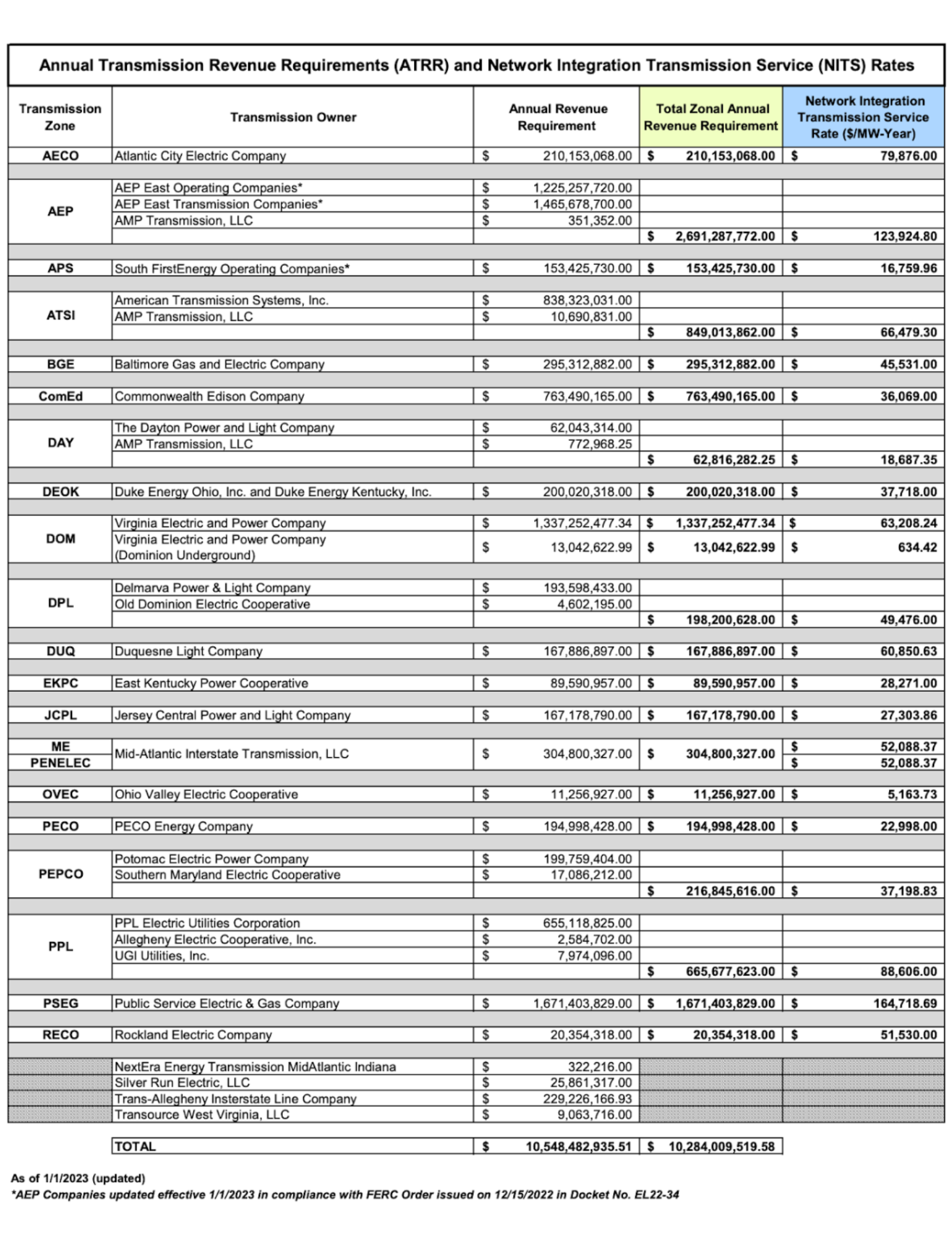Electrical power transmission charges are costs that cover the bulk transmission of electricity from the power plant to your local utility provider. Whether you are a customer located in a deregulated state and signed up with a retail energy supplier, or you are located in a regulated state, you must pay for the transmission of power in your electricity rate.
What Is Electric Transmission
Electric transmission is the process by which electricity is transported from generation plants to local utilities so it can be delivered to end-use consumers. In the U.S. there are over 200,000 miles of electric transmission lines that make up what is often referred to as the power grid. These power lines play a critical role in ensuring that the electricity supply is constant and reliable for both business and residential energy consumers.
Electric transmission in deregulated states is part of the electrical supply charges and is often measured in $/kW (see kW vs. kWh). Transmission line owners charge a certain tariff or rate to deliver electricity over their lines, which is oftentimes collected by retail energy providers.
Electrical transmission is often confused with electrical delivery, which is solely managed by local utility companies. Electrical delivery takes place over locally-owned electrical lines and not high-powered transmission lines.
Types Of Transmission Rates
Electric transmission rates are managed and set by state and federal energy regulatory bodies. These costs are ultimately paid by energy consumers in their rates for electricity. And, no matter if a consumer is paying a fixed or index-based energy rate in a deregulated state, or paying a set utility rate in a regulated state, transmission costs are included in the total electricity supply price. Let’s explore the various electric transmission rates below.
In each deregulated energy market, transmission rates are collected by retail electricity suppliers and/or electric utility companies on behalf of customers and then remitted to grid operators.
Network Integration Transmission Service (NITS)
NITS is a fee charged by transmission line owners that allows them to generate revenue at a regulated rate of return. There are not many new transmission lines being built giving transmission owners a monopoly when it comes to power grid ownership. Due to this fact, their revenue and profit margins are regulated in an effort to provide fair pricing to consumers.
NITS transmission charges allow transmission owners to recoup their total annual costs while earning a guaranteed income, also known as revenue requirements. These fees are set through a fixed rate or through a future rate that is set one year into the future. On an annual basis, transmission rates are adjusted to reflect actual costs.
Transmission Enhancement Charges
In an effort to make the power transmission network more reliable, many grid operators allow for Transmission Enhancement Charges. On the PJM electric grid, these charges are known as the Regional Transmission Enhancement Plan or RTEP.
These fees are collected by grid operators to incentivize and compensate transmission owners for upgrading, enhancing, and increasing the reliability of their transmission lines. In some regional territories, these charges are included in NITS.
Transmission Adjustments
Depending on the terms of your energy contract language, your rate might be subject to change with transmission rate adjustments. Many retail electric suppliers are now including clauses in their contracts that allow them to charge customers for additional fees incurred from a change in transmission rates. These hidden electric bill charges typically can happen when NITS charges are set one year in advance and later adjusted. Bill increases from adjusted transmission rates are energy pass-through charges and appear as separate line items on the customer’s bill.
How Are Electric Transmission Rates Calculated?
Similar to energy capacity charges, transmission rates are calculated using a customer’s demand (kW). Although capacity rates are set based on peak demand in Summer months, transmission rates are set monthly based on the customer’s Network Service Peak Load value (NSPL), or transmission tag. The transmission tag is often close to the peak demand for each billing period, although not always.
Transmission rates for electricity are then calculated using this formula:
(NSPL x Transmission Rate x Days In Period) / Forecasted Period Volume
Fixing vs. Floating Transmission Rates
If you own or manage a business in a deregulated state, you have many options when it comes to paying transmission rates. And, deciding on whether to fix your electric transmission costs for the term of your energy contract or to pay for them based on the cost of the market, depends on your specific business operation and your needs.
To Fix: Many commercial and industrial customers elect to fix energy costs with retail electric suppliers in an effort to control costs and estimate future expenses. Fixed electricity rates include transmission rates in the total price and allow customers to “set it and forget it”. Fixed transmission rates are ideal for those customers that want to know exactly what they will pay for each unit of electricity.
To Float: On the other hand, there is a solid argument against fixing transmission rates in your total power price, even if you elect to lock-in capacity and energy costs. Many times, retail suppliers will add a risk margin to a fixed rate as insurance against future unknown costs. And, since transmission rates can only be set one year in advance, you could pay handsomely for a multi-year fixed-rate contract. Many larger customers elect to pay for transmission rates at costs in order to avoid these extra fees.
Transmission Operators
Throughout the U.S. there are various electrical transmission operators who are responsible for managing the electrical transmission systems to ensure that there is always enough power supply to meet demand. In deregulated states, this role is often assigned to Independent System Operators, such as the NYISO in New York, or Regional Transmission Operators, such as PJM in the Mid-Atlantic states. In regulated states, public utility companies are often responsible for owning and managing transmission networks. Energy brokers help their customers understand transmission rates as they relate to their electric bills.
Transmission operators handle many different aspects of the electric power grid. They dispatch electric generation, forecast daily consumer demand, manage blackouts and brownouts, oversee grid enhancement projects, and ensure continual electric grid reliability.
Transmission Rate Tariffs
In regions governed by Regional Transmission Organizations (RTOs) and Independent System Operators (ISOs), the owners of transmission lines can earn returns on their investments through rates and yearly fees levied on energy suppliers and users. These fees, based on structured financial planning, must receive approval from the Federal Energy Regulatory Commission (FERC) to ensure they promote fair competition and maintain reasonable pricing.
The specific rates and fee structures differ among various RTOs and ISOs, but typically cover costs related to the recovery of:
- infrastructure investment
- financing of new projects
- charges for reliability services
- compensation for energy losses on the grid
Factors such as aging infrastructure, the integration of new energy sources, and shifts in energy demand have generally led to a gradual increase in transmission rates in most U.S. RTO and ISO areas.
Let’s explore some of the current transmission tariffs in the PJM ISO territory:

If we look at the PECO tariff compared to the PPL tariff, you will notice a large discrepancy between the Network Integration Transmission Service Rate.
- PECO is $22,998 / MW / Year
- PPL is $88,606 / MW / Year
Even though these two utilities are neighbors, there is a significant increase in transmission rates in PPL when compared to PECO. The discrepancy could be due to increased investment in upgraded transmission lines in the PPL network. Since these transmission owners are entitled to a return on their investment, this could cause NITS rates to increase in the short term.
For customers with locations in the PPL electric territory, you might be wondering why your neighbors in PECO are paying so much less for electricity even though you are both located on the same PJM grid. One factor could be local electricity congestion costs, although these fluctuate in real-time based on local supply and demand. The real culprit driving up PPL electric prices is the significant increase in electrical transmission costs.
Want To See What You’re Paying For Transmission Rates?
Not many consumers are aware of the costs they pay to transmission operators. And in some cases, you might be overpaying your supplier for transmission rates, especially if you recently implemented an energy efficiency strategy. Contact us today for an audit of your utility bill and to determine if you can save on transmission costs.





